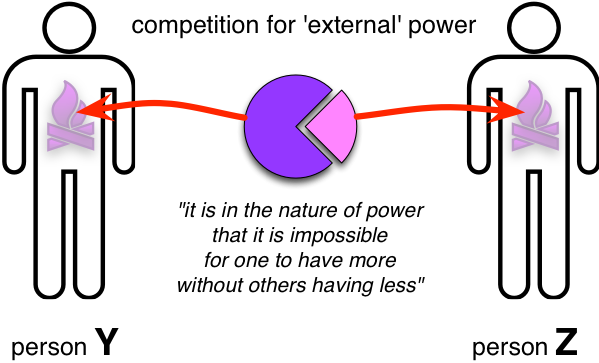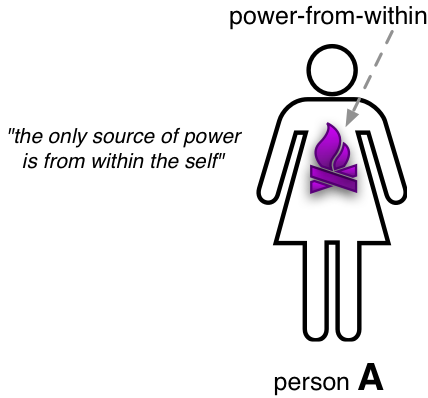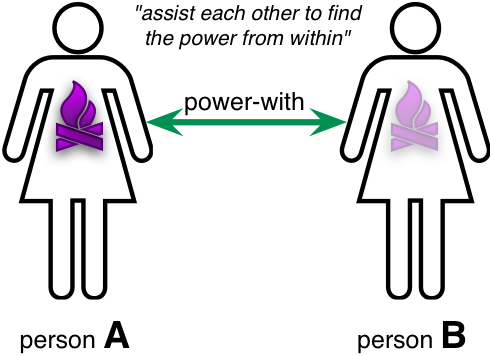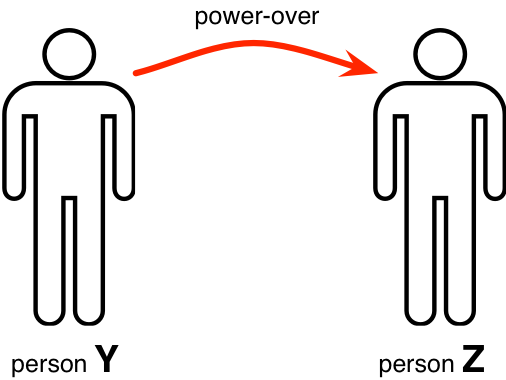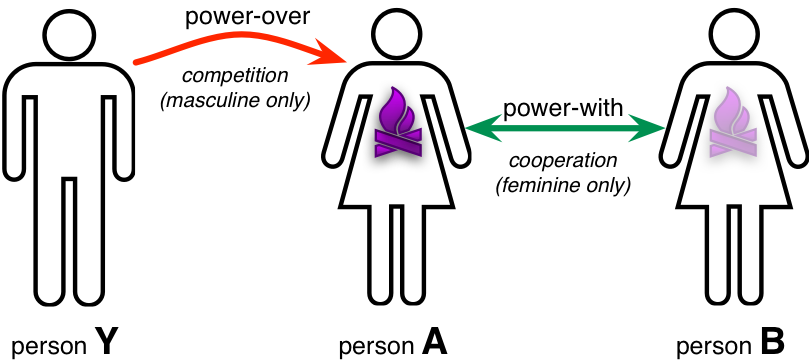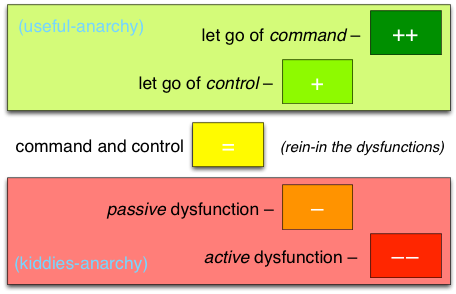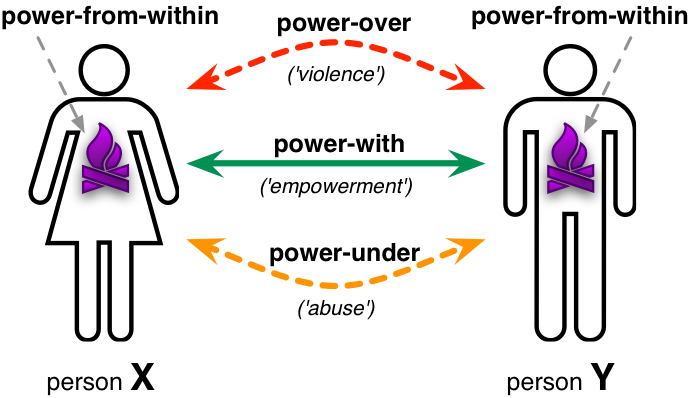Link: http://weblog.tetradian.com/2014/11/07/rbpea-on-power-and-gender/
What is power? Where does it come from? Where does it go? Who has it? Who doesn’t have it? Who should have it? Who shouldn’t have it? And why? – or why not, for that matter – to any of those questions…?
Perennial questions indeed, in just about any social context. But let’s try applying some of our RBPEA tactics to those questions, and see what comes up – perhaps particularly in terms of power and gender, given the linking-theme for this series of posts.
First, though, a quick refresh on the SCAN-based systems-thinking checklist we’ll use for this:
So let’s start off with a hoary old classic: the notion that power exists as a kind of magic pool or reservoir, somewhere ‘out there’ (though we never quite know where), of which there’s only ever a fixed amount. We don’t really know what it is, but we do know that we want our share of the pie – and if necessary we’ll fight others for it. Or more of a share, if we can. It’s perhaps best typified by a phrase I once saw from a Marxist-style ‘pro-feminist’ men’s group, an assertion that “It is in the nature of power that it is impossible for one to have more without others having less”:
It was this kind of thinking that led to a very popular assumption in the feminist literature I came across around the late 1970s or so: that if women felt they didn’t have much power in their lives, it was because men had taken it all – had stolen women’s rightful slice of the pie. In which case, all that women needed to do to become powerful was to set up structures to disempower all men as much as possible – to “force him to give up his position of power”, as the Duluth Model put it. When men have less power, women must, by definition, automatically have more: men’s ‘stolen’ slice of the pie would somehow magically transfer itself back to women – without women actually having to do anything to make it happen. Disempowering men inherently empowers women: that was the thinking. It was, as I say, a very popular idea – and unfortunately still is, in many circles…
As a ‘pro-feminist’ man in that period, I spent a lot of painful effort putting myself down, blaming myself for all women’s ills, as feminist theory of the time commanded me to do. The catch was that it just didn’t work: I felt a lot worse, of course, but the women around me didn’t feel any better – in fact they often got even angrier and more demanding because it didn’t work. Everyone lost out: and it just kept on getting worse and worse.
If we apply a bit of systems-thinking, though, it immediately becomes obvious what went wrong: the power-model was all based on a Simple idea – in this case, an arbitrary and untested assumption about Reciprocation, without any linkage to anything else. We had no idea of what power was, or where it was situated: all that we knew was that we all felt that we didn’t have it, and hence assumed that someone else (unspecified) must have taken it. Not very bright of us, when we look at it like that…
At this point, to break the deadlock, up steps an important feminist theorist, Starhawk (Miriam Simos). In her 1980s books Dreaming The Dark and Truth Or Dare, she develops a fundamentally-different power-model, based on a concept of power-from-within. “The only true source of power”, says Starhawk, “is from within the self”:
In this model, we still don’t know what power is, but we do at least know where it is, where it comes from, and, from that, also have some idea of how to create it. That’s a huge improvement over the ‘pie-slice’ power-model.
She then adds an important twist, about the social aspects of power. “We can assist each other”, she says, “to find the power from within” – an interaction that she describes as power-with:
In systems-thinking terms, what we have here is a Reframe that combines Reciprocation with Resonance, providing a positive-feedback loop through which more and more power can be created, seemingly from nowhere, but ultimately from within each individual.
The catch, of course, is that the old ‘pie-slice’ power-model hasn’t gone away: there are all too many people who believe in the old slogan from The Godfather, that “true power cannot be given, it must be taken“. This creates an interaction that Starhawk describes as power-over:
Finally, she identifies cooperation exclusively with power-with, and competition exclusively as power-over – which probably makes sense enough at first glance, as long as we don’t look too closely at that somewhat-arbitrary conflation.
And unfortunately we do need to look more closely, because at this point the whole model suddenly collapses into a dysfunctional mess of arbitrarily-gendered conflations. Seemingly out of nowhere, she asserts that power-with is not only always cooperative and always supportive, but inherently ‘feminine’; and power-over is not only always competitive and always destructive, but also inherently ‘masculine’. Power is created only by women, and between women; and men have power only because they steal it all from women via power-over, whilst also suppressing women’s power-with and, ultimately, power-from-within. In visual form, Starhawk’s power-model looks like this:
Given the near-ubiquity in feminist literature of the time of slogans such as “men are the problem, women are the solution”, it’s easy to see how that part of the model arose: but it doesn’t take much of an assessment to show that, bluntly, that one error reduces this otherwise very useful model to little more than a self-serving, self-congratulatory, blame-raddled mess. Which is unfortunate – to say the least.
Those concepts of power-from-within, power-with and power-over all work really well: no doubt about that, and they’re all groundbreaking in their own ways. But the absolutism and the extreme asymmetry beyond that point – the lack of Reciprocation in the interaction-system – are classic giveaways that, from a systems-thinking perspective, would warn us straight away that not only is something seriously wrong with Starhawk’s model, but that something important is missing too. Not only missing, in fact, but so actively ignored that it kinda suggests there’s a really deep ‘undiscussable’ hidden away in there…
Before we tackle that, let’s look again at those conflations around cooperation and competition, supportive versus destructive, and ‘masculine’ versus ‘feminine’.
The gendering of cooperation and competition is the easiest to resolve: we don’t need systems-thinking tools for that, all we need do is look around. Everywhere we see both men and women cooperating with each other, and competing with each other, in many different ways. Although, yes, there are some apparent gendered-overtones, the assertion that gender can be assigned in an absolute sense either to cooperation or to competition – as Starhawk does in her model – is simply not supported by the real-world evidence. Let’s just drop it.
Next, that conflation of cooperation with supportive, and competition with destructive. Again, look at the real-world. Competition can be destructive, yes – power-over, indeed, exactly as in the ‘pie-slice’ model. But it can also be constructive, such as when a team of sprinter-pacemakers push a longer-distance runner to performance she could not have achieved on her own. We’d also frequently compete with ourselves to push us to develop our own skills: that’s the basis of gamification in single-user apps, for example. And likewise, whilst cooperation might usually be supportive, it can also be destructive – such as when people group together (cooperation) to tear someone else down (dysfunctional-competition). So again, the conflation in Starhawk’s model is not supported by the real-world-evidence, and it’s best to just drop it. Instead, in practice, the crucial issue with both cooperation and competition is not those social modes themselves, but the overall aim of the interaction – whether it is ‘with’ the Other, in one of many different senses, as a form of power-with; or ‘against’ the Other, likewise in one of many different senses, as a form of power-against.
As a quick summary-so-far:
- for the most part, competition and cooperation are not gendered as such
- cooperation and competition may each be either constructive or destructive in aim – cooperation is not inherently-supportive, and competition is not inherently-destructive
- the term ‘power-with’ may usefully be contrasted with ‘power-against’ – but at least in context of cooperation and competition, neither gender could be assigned inherently, in absolute sense, to either of these
However, we still haven’t fully resolved the gendered assertions around power itself – the assertion that constructive power-with is exclusively-feminine, and destructive power-over exclusively-masculine. And we also still have no actual definition of what power is – which is probably a point that we need to deal with first.
To resolve that, call on systems-thinking again, and pull in an example from another domain. And in physics, the term ‘power’ in effect represents ‘the ability to do work’ – with work formally defined as ‘the rate at which energy is expended’. If we transfer that into human terms, then power is the ability to do work.
The catch is that that definition could just as easily apply to slavery – ‘arbeit macht frei‘ and all that – so we’d best urgently add at least one rider to that definition: Power is the ability to do work, as an expression of personal choice, personal responsibility and personal purpose.
But if power is the ability to work, then what is ‘work’? The short answer is that work is whatever people do. Digging a ditch is work; solving a technical problem is work; but so is calming a fractious child, or reclaiming hope from despair. Power is the ability to do work, as choice; and work is whatever people choose to do.
To get a bit more clarity on what work actually is, and also link it back to our other domains in enterprise-architecture, we can also usefully do a crossmap here to the asset-dimensions in Enterprise Canvas:
- physical – working on ‘things’, anything tangible or physical
- mental [‘virtual’] – working on ideas, concepts, problems
- emotional [‘relational’] – working on relationships with others
- spiritual [‘aspirational’] – working on personal meaning and purpose, sense of self, or relationships with ‘that which is greater than self’
Note that, exactly as with the asset-dimensions in Enterprise Canvas, most real contexts involve work on multiple dimensions at once. Starhawk’s power-with, almost by definition, involves relational work, creating and maintaining connections between two or more people; and her power-from-within is, in essence, spiritual-work, working on one’s sense of self, meaning, purpose; so when power-with actually happens, it’s a process within which both relational-work and spiritual-work take place at the same time, in different ways for each of the parties in the interaction. In team-work all of the power-with interactions are going on at the same time as the mental and/or physical work of the overall team.
In short, all of those different forms of functional-power interweave with each other, all of the time. To make sense of a context, it’s often useful to gently tease apart – in conceptual terms, at least – all of those different threads of work and power: yet it’s essential to remember that in the real world they only work when working together. Divide-and-rule really doesn’t work here…
To reframe all of the above in Starhawk’s terminology: power-from-within is the ability to source and access human power from within the self.
And power-with is the ability to assist each other to generate and access power-from-within, and to share that power with others.
Or, to crosslink it back to that crucial point about choice, power-with is the ability to do work, as an expression of shared choice, shared responsibility and shared purpose.
Notice that none of that is inherently gendered. Yes, there are all manner of gender-stereotypes around in every culture, about work and work-to-be done – for example, assumptions or assertions that men are better at thinking, or women are better at relating. Real-world evidence, though, quickly shows us that most of those assertions are arbitrary at best: most of the differences between the genders are relatively minor, and are more than compensated for by much larger variances within each gender. In most contexts, most of those gender-stereotypes are more of a hindrance than a help, especially when dealing with any individual case or context.
At this point, though, we need to return to those last key loose-ends:
- the nature of power-over or power-against or whatever we’re going to call it
- the assertion that whatever-it-is is inherently or exclusively ‘masculine’
- that more-than-just-a-bit-nagging suspicion that there’s a huge gap in Starhawk’s model – some kind of carefully-ignored ‘elephant in the room’
For suggestions about the nature of power-against, we could again turn to the Duluth Model, which in essence provides us with a kind of catalogue of what goes wrong in interpersonal and wider relationships:
- coercion and threats
- intimidation
- economic abuse
- emotional abuse
- using privilege
- using isolation
- using children
- minimising, denying and blaming
There are also two other serious forms of abuse that, for unknown reasons, are not included in the original Duluth model:
- sexual abuse
- third-party abuse
(Third-party abuse occurs where someone uses misinformation or misdirection so as to set up ‘authority-figures’ and other third-parties to enact some form of abuse or violence on their behalf against some Other. It’s a particularly difficult and complex form of abuse to identify and resolve, because the initiating-perpetrator of the abuse is concealed or purports to be a ‘victim’, and, very often, the real victim is falsely purported to be the ‘perpetrator’ of some other misdeed or abuse. In forms such as rumour-mongering, for example, it’s the one type of abuse of which school-students report as being most afraid.)
When we look at that catalogue of woe, perhaps the one common factor throughout is this: that in all too many contexts, social ‘power’ is presumed to be the ability to avoid work – rather than the ability to do work. Which explains a lot…
First, and perhaps most often missed, is that it doesn’t work – literally. Since its definition of ‘success’ is that work is avoided, then by definition the more ‘successful’ it is, the less actual work gets done. More worrying is that, as a delusion, it’s extremely addictive: because of the deep-seated belief that it ‘should’ work, it’s therefore applied more and more as less and less successful outcome is achieved – particularly when the respective work can only be done by the self, such as in all forms of spiritual-work (‘sense of meaning and purpose’, etc).
It also leads to a more worrying social-delusion that power and status should pertain proportionally to those who do the least work, or who most entrap others into doing the work on their behalf. Hence, all too often, dysfunctional business-hierarchies, or hierarchies of all kinds. Hence, too, the social reality that the closer one gets to doing effortful physical-work, the less one gets paid – of whom the extreme are mothers and other carers, who do some of the hardest work of all, yet in our insane money-based economics are deemed to be ‘worth’ almost nothing.
(I’ll admit I get quite angry about that – the multi-layered injustice implicit in the societal denigration of parenting, elder-care and the like, often internalised by the victims of that abuse in phrases such as “I don’t work, I’m only a mother”. What’s been most disappointing is that in recent times some of those most actively denigrating motherhood have been self-styled ‘feminists’ such as the ‘The Office For The Status Of Women’, a high-level policy-unit attached to the Australian Prime Minister’s office. Oh well…)
If we explore the Duluth Model in more depth, it becomes clear that there are two quite distinct themes going on within all of those forms of abuse, but interweaving with each other in different ways. To maintain the alignment with Starhawk’s model, we could describe these two forms of power-against respectively as power-over and power-under.
Unsurprisingly, this ‘power-over’ is close to the implications of the classic ‘pie-slice’ power mode: it’s actively dysfunctional. For the purposes here I’d define it as follows: power-over is any attempt, by anyone, toward anyone, to prop Self up by putting any Other down. (There’s also a ‘lose/win’ version, putting self down to prop others up: that’s often thought of as socially praiseworthy, but in reality it’s ultimately every bit as dysfunctional as the ‘win/lose’ version.) The colloquial term for power-over is ‘violence’. Notice the key point about “from anyone, to anyone”: ‘the Other’ might well also be Self – such as beating myself up for failing to get this written exactly on-schedule.
‘Power-under’ is a bit more subtle, not least because, for the most part, it’s passively dysfunctional – it’s more in what isn’t done, rather than in what is. For the purposes here I’d define it as follows: power-under is any attempt, by anyone, toward anyone, to offload responsibility onto the Other without their engagement and consent. (As with power-over, there’s also a ‘lose/win’ version, taking on responsibility from the other without their engagement and consent – and again as with power-over, it’s often seen as praiseworthy but in fact is equally as dysfunctional as the ‘win/lose’ version.) The colloquial term for power-under is ‘abuse’. Notice again the key point about “from anyone, to anyone”, because again ‘the Other’ may actually be the Self – such as in my trying to put off writing this until tomorrow.
Collectively, power-over and power-under are aspects of what I described in that summary earlier above as ‘power-against’.
We can also usefully crossmap all of this onto the SEMPER model of power and effectiveness in the workplace:
- ‘++‘: ‘individual as wholeness-responsibility’ – outcome of full power-from-within, usually grounded in support of collective power-with
- ‘+‘: ‘organisation supports individual’ – collective power-with
- ‘=‘: ‘command and control’ – reins-in the dysfunctions sufficient to leave some space for self-generated power-from-within, without power-with
- ‘–‘: ‘passive-dysfunction’ – individual and/or collective power-under
- ‘––‘: ‘active-dysfunction’ – individual and/or collective power-over
When fully supported by mutual power-with, constructive power-from-within drives an upward-spiral into ever-greater achievement – although technically a form of useful-anarchy, since it’s always ultimately an expression of the individual as individual. By contrast, the huge danger of power-against is that, in any form, they can become deeply addictive, driving a downward-spiral into full-blown ‘kiddies’ anarchy’.
But what about gender and power-against – such as in Starhawk’s assertion that power-over (and, by implication, power-under) is inherently ‘masculine’? The Duluth Model essentially follows Starhawk’s power-model, and arbitrarily asserts that all forms of violence and abuse are exclusively male. For this reason, Duluth’s descriptions of abuse and violence only use male-pronouns for ‘perpetrator’, and female-pronouns for ‘victim’.
Yet from a systems-thinking perspective, it again becomes clear that there’s a really simple ‘thought-experiment’ that we could apply here: swap the gender-pronouns in each of the descriptions, and see if it still makes sense, in terms of real-world practice and real-world evidence.
Which it does. Exactly as much as the original ‘it’s all men’s fault’ way round.
Which means that there is no defensible justification, at all, for the gender-assertions on which the entire Duluth Model is based.
Which means that all of those assertions about ‘it’s all men’s fault’, and the resultant demands on men within that model, are built almost entirely around ‘Minimising, denying and blaming’, and third-party abuse.
Which means that in its own terms, the Duluth model is inherently violent and abusive; and that far from reducing violence and abuse, the entire model is structured in such a way as to create it. And then blame the victims of that violence for the violence.
Oops…
So with regard to those attempts at gendering power and violence in Starhawk’s power-model and elsewhere, let’s just drop any gendering of power. Completely. Just drop it. It’s fundamentally dishonest, and it doesn’t work – in fact all it does is makes things worse, for everyone.
(Okay, if we look at those Duluth categories, it’s true that there are indeed some gender-overtones, especially if we look at it in terms of classic gender-stereotypes and suchlike. But again, the differences between the sexes are far less than the differences within the sexes, so it’s all a bit moot anyway, especially when we get down to the level of the individual. The simplest way to put it is that any attempt at gendering of power, violence and abuse, in any direction, is a red-herring, a distraction that we really don’t need – and, more to the point, is usually a cover-up for other forms of violence and abuse, particularly as ‘Minimising, denying and blaming’, or ‘Third-party abuse’. Drop it: just drop it. That’s all that needs to be said there.)
The blunt reality is that the refusal to acknowledge women’s violence – violence and abuse by women – is ‘the invisible elephant’ that cripples Starhawk’s power-model. It’s not just Starhawk, either: it seems more like a total taboo that runs throughout almost all of feminist and ‘pro-feminist’ theory and literature, certainly since around the early 1980s. We see variants of much the same taboo evidenced throughout most Western-culture media since that period, too.
I have no idea why that taboo should even exist, let alone be so predominant, but the crucial point that needs to understood is that the refusal to acknowledge even the fact, let alone the true scale, of women’s violence, hurts women as much if not more than men. One first-hand example for me was that I originally got involved in domestic-violence resolution to help two of my lesbian friends after they’d ended their relationship in a knife-fight, yet had been refused any help from the state-run domestic-violence service because there was no man to blame. There are occasional signs of something resembling honesty on this overall theme – the film Mean Girls is one example, based on Rosalind Wiseman’s research-based book ‘Queen Bees and Wannabes‘ – but these tend to be rare exceptions to an otherwise almost total blackout in media and elsewhere. Which is a pity, really – for women especially.
Once we do drop the pretence that women’s violence doesn’t exist, then immediately the whole power-against part of the power-model makes sense in systems-thinking terms: it’s symmetrical and balanced – even if at times only a balance of terror, of mutual dysfunction… In effect, rather than Starhawk’s arbitrarily gendered ‘power-over’, what we too often see happening in dysfunctional-relationships is a classic codependent pairing, where each of the parties swap back and forth between the relative roles of ‘perpetrator’ and ‘victim’, continually switching from one power-against tactic to another, in a wildly unstable tug-of-war: and yet the overall relationship remains relatively stable – so much so that if either party tries to pull out of the mess and end the mutual-dysfunction, the other will usually put renewed effort to drag them back in. In that sense, we’d need to replace the ‘power-over’ part of Starhawk’s power-model with something more like this:
Remember, though, that gender is not the key point here: whilst it’s true that the parties in a dysfunctional ‘power-against’ relationship might well be respectively male and female, but they could just as easily be both male, both female, same or different ages, same or different cultures, even human and non-human once we start to look in more depth at relationships with animals and the like. It’s all about power – either power-with and power-from-within, ‘the ability to do work’; or power-against, power-over or power-under, the delusion of ‘the ability to avoid work’. Those are the only two choices – power-with, or power-against: and power-against doesn’t work – for anyone.
Once we drop the pointless gendering in Starhawk’s power-model, what we end up with is a power-model that works, that makes practical sense, and whose symmetry makes it much more defensible both from a systems-thinking perspective and in terms of real-world evidence too. We could summarise it visually as follows:
There’s one more point we need to explore before we move on, though, and that’s the relationship between power and responsibility. To put it at its simplest, if there’s no responsibility, there’s no power. If we go further back in feminist history, it’s clear that at that period this crucial interrelationship was reasonably-well understood. For example, at the Seneca Falls Convention in 1848 – in essence, the origin of the modern notion of ‘women’s rights’ – we find this key complaint in the Convention’s ‘Declaration of Sentiments‘:
He has made her morally, an irresponsible being, as she can commit many crimes with impunity, provided they be done in the presence of her husband.
Note, though, that it wasn’t solely about “in the presence of her husband”: if a married woman committed a crime, the husband alone was legally liable for the offence. Without legal responsibility for her own actions, the only way that this can possibly be made to work in practice is for the woman to be assigned the same legal status as an infant: in other words, no responsibility, but also no power. Or, to put it the other way round, in terms of that power-model above, the only way in which women could validly be assigned the exact same social and legal power as men is if they have the exact same legal responsibilities. Anything less than that, in terms of responsibilities, would imply some form of structurally-imposed power-under on women’s behalf – inevitably triggering off a perceived ‘need’ for some form of power-under or power-over to defend and balance against that power-under, and onward into a codependent downward-spiral. In short, not a good idea. Which is precisely why the delegates at the Seneca Falls Convention included that concern in their ‘Declaration of Sentiments’.
But unfortunately that rejection of responsibility is exactly what has been happening in feminist theory and practice over the past few decades. Up until the late 1970s or so, it’s visible mostly in terms of omission – such as its absence from Germaine Greer’s definition of feminism, which we’ll see in a later post in this series. But from around the early 1980s onwards, it becomes much more explicit, and eventually almost total, coupled with ever more insistent demands for ‘women’s rights’. I remember being on a ‘women’s rights’ march in Melbourne a couple of decades or so ago, where one of the back-and-forth chants was:
What do women want? Everything!
What are we responsible for? Nothing!
And yet I don’t think a single woman on that march recognised the inherent absurdity in what they were chanting…
The catch with ‘rights’, as I’ve explained in various posts here, is that they simply don’t work: they combine a declaration of a desired outcome – yet absent of any indication of how the heck it can be achieved – with an assertion of absence of responsibility: it’s my right, others alone are responsible for giving it to me. This is true of all purported rights, but it’s especially problematic when the rights are inherently asymmetric – as in the ‘women’s rights’ case – because then the excluded group (i.e. ‘not-women’, in this example) are arbitrarily assigned all of the responsibilities but none of the ‘rights’: again, structurally-imposed power-under, hence, again, not a good idea.
From a Simple perspective, rights look like a great idea: an absolute, easily-understood answer to real-world ills. Unfortunately, what they really are is a tame-problem ‘solution’ to a wild-problem context – and that always causes the respective problem to change from merely complex to deeply-intractable ‘wicked’. To get the desired outcomes of the respective ‘rights’, we need to apply a Reframe, to restructure ‘rights’ as mutual interlocking responsibilities. (See the post ‘An architecture of responsibility‘ for a worked example regarding ‘rights of possession’.) Hence, for example, a reframe for ‘women’s rights’ – or any other purported ‘rights’ – would begin somewhat as follows:
- what is the desired outcome for each of the respective ‘rights’ (apply a Five Whys or suchlike to identify the real deeper needs behind the respective ‘right’)
- identify the mutual responsibilities and interlocks of actions, decisions and behaviours that would enable the respective outcome in real-world practice
- identify checks and balances that would ensure that the responsibilities are perceived as ‘fair’ to all respective parties
The key problem with so much of the ‘women’s rights’ discourse is that it’s almost completely absent of any notion of mutuality or fairness: instead, it’s all about a one-sided ‘entitlement’, powered by vast amounts of self-dishonesty and Other-blame. Which is precisely why it’s still going nowhere at present – and is unlikely to go anywhere further until those issues are honestly faced. Which is kinda sad, really, because this kind of mess hurts everyone – and yet, with quite a small amount of real systems-level thinking, the structural aspects at least of the mess could be resolved with very little effort at all.
I guess that’s how I most feel about the current mess on power and gender: a crushing sense of sadness. Almost all of that pain and misery could have been averted if the people involved had bothered to think, for more than a few seconds, before indulging in power-models that might have looked good on the surface but were hopelessly inadequate for any real-world use. A quick glance at the SCAN frame at the top of this post should be enough to point out the more obvious of the problems: the Marxist-style ‘pie-slice’ model is not so much Simple as ludicrously simplistic; and Starhawk’s power-model, if somewhat better in some ways, is still a classic Complicated, seemingly ‘logical’ yet rendered utterly unusable by a mess of unexamined assumptions. Oh well.
The one theme I’ll admit to some amount of anger about is that so many self-styled ‘women’s activists’ have so repeatedly demonstrated such an abysmal lack of thought, awareness, observation or empathy – a theme we’ll return to in the next post in this series. For example, it never seems to have occurred to them that men don’t actually feel any more powerful than women do – and in most cases never have done. By now, those activists must have tried, and demanded, just about every possible combination of blaming men for everything, and trying to dump onto men alone the responsibility for everything: and none of it has worked well, for anyone – an outcome that should be entirely unsurprising, given the analysis above. And yet all of that pain could have been averted by little more than a few moments’-worth of thought and observation, coupled with perhaps a pinch or two of much-needed self-honesty. It’s probable, in fact, that the only real outcome of some five decades’-worth of ubiquitous, insistent, ever-increasing ‘feminist’ tirades, in Western cultures especially, is that it’s made life for those men even more hellish than it already was. Hardly grounds for congratulation, I’d suggest…?
If we want to resolve those all-too-real problems around power and gender, for everyone, we really do need to do better than what’s been done so far… But I do hope that that reworked power-model above can indeed provide something useful to help in that. Over to you, anyway.
Practical applications
(A reminder that these ‘Practical Applications’ sections are about taking any insights from RBPEA work and applying them back in the more everyday levels of EA practice. In most cases – particularly if we’re working mainly in the IT-space and suchlike, as so many ‘enterprise’-architects still do – this won’t (and probably shouldn’t) involve any concerns about gender at all. Which is fine, because the focus on gender above was as a test-case to trigger insights, not necessarily as a domain of action. The other aim here is about fractality, testing our EA tools and techniques right out at the far ends of the fractal scale so as to verify their applicability and robustness in our more everyday domains.)
Probably the most useful point from this RBPEA session is to take those definitions around power, and apply them to everyday contexts. A refresher on those definitions again:
- power is the ability to do work (or, in a human context, extended as ‘the ability to do work, as an expression of choice, responsibility and purpose‘)
- delusory-’power’ is ‘the ability to avoid work’
- power-from-within is the ability to source and access power from within the self (in general, applicable only to humans or other animals)
- power-with is the ability to assist each other to generate and access power-from-within (alternatively, the ability to do work, as an expression of shared choice, shared responsibility and shared purpose) (mostly human and other animals, but the assisting party may be IT and/or machine in some contexts)
- power-over is any attempt, by anyone, toward anyone, to prop Self up by putting any Other down
- power-under is any attempt, by anyone, toward anyone, to offload responsibility onto the Other without their engagement and consent
And a perhaps-useful reminder:
- ‘rights’ will need to be restructured as interlocking mutual responsibilities
At the first level, apply these solely to technical concerns, such as interfaces between systems:
- What is the work to be done?
- What energies, assets and resources will be needed for that work to be enabled and enacted?
- Who or what has the power – the responsibility or ‘response-ability’ – to do that work?
- Where do any structures risk creating a context where one or more systems prop themselves up by putting others down – such as by demanding arbitrary priority, or creating a deadlock?
- Where do any structures risk creating a context where one or more systems attempt to offload responsibility onto others without their engagement or consent – such as in a mission-critical control-system left to run inappropriately ‘open-loop‘?
- What mutualities and interlocks are required to ensure that the system overall runs in a balanced way that is ‘fair’ to all parties in the interaction?
- Who or what decides what constitutes ‘fair’ within the design and operation of the system?
Apply these questions also to broader-context concerns. For example, what happens when you reframe security and access from ‘rights’ to mutual interlocking responsibilities? What are those responsibilities? What are the mutualities and interlocks that make it work for all parties? What’s needed to maintain the balance of responsibilities across the whole domain? The ‘Validation‘ model in Enterprise Canvas may also be helpful for this.
Power-issues of many different kinds are obviously also utterly central to most EA work, especially once it moves beyond a strict IT-centric domain. The checklist above applies in exactly the same way, but please, please, use that checklist with care. In particular, do not try to use it in the complexities of human contexts without having first had a significant amount of practice on relatively straightforward technical-systems at progressive levels of complexity, from Simple to Complicated to Ambiguous to Not-known. Although the critiques in the post above focus primarily on power and gender, the similar (and mostly non-gendered) power-dysfunctions in the workplace too often manage to be even worse: in the business-context, the term ‘kiddies’-anarchy’ may gain all too real a meaning… and the wrong kind of carelessness around human power-issues can be a career-killer, or worse. You Have Been Warned, please?
For a practical example, consider the balance of responsibilities, mutualities and interlocks needed across the entire set of investors and beneficiaries in an enterprise: the ‘Investors‘ model in Enterprise Canvas maybe useful as a crosscheck for this.
You may also find useful the ‘manifesto’ reference-sheet on power and responsibility in the workplace, that I wrote to accompany my book Power and Response-ability: the human side of systems – the ‘manifesto’ is a free download in PDF format from the Tetradian Books website.

